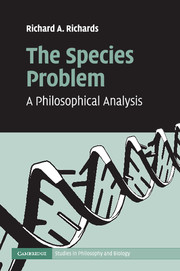Book contents
- Frontmatter
- Contents
- Acknowledgments
- 1 The species problem
- 2 The transformation of Aristotle
- 3 Linnaeus and the naturalists
- 4 Darwin and the proliferation of species concepts
- 5 The division of conceptual labor solution
- 6 Species and the metaphysics of evolution
- 7 Meaning, reference and conceptual change
- 8 Conclusion
- Bibliography
- Index
3 - Linnaeus and the naturalists
Published online by Cambridge University Press: 04 April 2011
- Frontmatter
- Contents
- Acknowledgments
- 1 The species problem
- 2 The transformation of Aristotle
- 3 Linnaeus and the naturalists
- 4 Darwin and the proliferation of species concepts
- 5 The division of conceptual labor solution
- 6 Species and the metaphysics of evolution
- 7 Meaning, reference and conceptual change
- 8 Conclusion
- Bibliography
- Index
Summary
THE ESSENTIALISM STORY REDUX
Those who understand Aristotle's project to be an essentialist system that classified organisms into unchanging species kinds on the basis of essential properties typically see a similar essentialism in many pre-Darwinian naturalists. In a passage quoted at the beginning of the previous chapter, Daniel Dennett claims that: “The taxonomy of living things that Darwin inherited was thus a direct descendant, via Aristotle, of Plato's essences” (Dennett 1995: 36). Here Dennett seems to be implying that, from Aristotle to Darwin, the property essentialism of the Essentialism Story was pervasive and predominant. Marc Ereshefsky describes this standard view:
[T]he common philosophical stance towards species was essentialism. Linnaeus, John Ray, Maupertuis, Bonnet, Lamarck, and Lyell all adopted an essentialist (or typological) view toward systematics … On this view, classification systems highlight natural kinds – groups whose members share kind-specific essences …According to biologists who adopted an essentialist view of species, species have the same role in biological taxonomy as the chemical elements have on the periodic table. All and only the members of a species taxon should have a common essential property.
(Ereshefsky 1992: 188–189)Of the group mentioned by Ereshefsky, the Swedish botanist Carolus Linnaeus is perhaps the most prominent and is specifically seen as working in this essentialist tradition. Typically Linnaeus is also taken to have adopted Aristotle's method of division.
- Type
- Chapter
- Information
- The Species ProblemA Philosophical Analysis, pp. 49 - 77Publisher: Cambridge University PressPrint publication year: 2010



